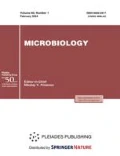Abstract
The succession analysis of bacterial diversity in the A horizons (rich in organic matter) of three contrasting types of soil—burozem, soddy gley soil, and chernozem—showed that the bacterial diversity of soil microcosms in humid regions can be adequately evaluated only if soil samples are incubated at different soil moisture contents. A complete account of actinobacteria and proteobacteria requires the levels of soil moisture corresponding to the maximum capillary–sorption moisture and capillary moisture, respectively. The bacterial diversity, whose value was maximum on the 40th day of succession, was higher in soddy gley soil than in burozem. The taxonomic structures of the bacterial communities of these two types of soil were different. After wetting chernozem samples from arid regions, the soil bacterial community changed insignificantly with time and drastically differed from that of soils from humid regions. The difference in the bacterial diversity of soils was the most distinct when it was evaluated by measuring the proportion between proteobacteria and actinobacteria.
Similar content being viewed by others
References
Alekhina, L.K., Nevskaya, D.V., Dobrovol'skaya, T.G., and Zvyagintsev, D.G., Bacterial Diversity of Forest Soils (Succession Analysis), Mikrobiologiya, 1997, vol. 66, no. 4, pp. 558–562.
Alekhina, L.K. and Dobrovol'skaya, T.G., Dynamics of the Bacterial Complexes of Soddy Gley Soil in the Process of Its Drying, Pochvovedenie, 1999, no. 9, pp. 1140–1143.
Metody pochvennoi mikrobiologii i biokhimii (Methods in Soil Microbiology and Biochemistry), Zvyagintsev, D.G., Ed., Moscow: Mosk. Gos. Univ., 1991.
Dobrovol'skaya, T.G., Skvortsova, I.N., and Lysak, L.V., Metody vydeleniya i identifikatsii pochvennykh bakterii (Methods for the Isolation and Identification of Soil Bacteria), Moscow: Mosk. Gos. Univ., 1989.
Bergey's Manual of Systematic Bacteriology, 9th ed., Holt, J.G. et al., Eds., Baltimore: Williams &; Wilkins, 1993. Translated under the title Opredelitel' bakterii Berdzhi, Moscow: Mir, 1997.
Bergey's Manual of Systematic Bacteriology, 9th ed., Holt, J.G. et al., Eds., Baltimore: Williams &; Wilkins, 1993.
Voronin, A.D., Osnovy fiziki pochv (Fundamentals of Soil Physics), Moscow: Mosk. Gos. Univ., 1986.
Kozhevin, P.A., Mikrobnykh populyatsii v prirode (Microbial Populations in Nature), Moscow: Mosk. Gos. Univ., 1989.
Kochkina, G.A., Succession of Soil Microorganisms and the Successional Role of Particular Microbial Populations, Cand. Sci. (Biol.) Dissertation, Moscow: Moscow State University, 1981.
Zvyagintsev, D.G., Pochva i mikroorganizmy (Soil and Microorganisms), Moscow: Mosk. Gos. Univ., 1987.
Polyanskaya, L.M. and Zvyagintsev, D.G., Microbial Succession in Soil, Russian Sci. Rev. Physiol. Gen. Biol. Rev., Harwood, 1995, vol. 9, Part 1, pp. 1–65.
Dobrovol'skaya, T.G., Chernov, I.Yu., and Zvyagintsev, D.G., About the Structural Indices of Bacterial Communities, Mikrobiologiya, 1997, vol. 66, no. 3, pp. 408–414.
Author information
Authors and Affiliations
Corresponding author
Rights and permissions
About this article
Cite this article
Alekhina, L.K., Dobrovol'skaya, T.G., Pochatkova, T.N. et al. Evaluation of Bacterial Diversity in Soil Microcosms at Different Moisture Contents. Microbiology 70, 731–737 (2001). https://doi.org/10.1023/A:1013100218465
Issue Date:
DOI: https://doi.org/10.1023/A:1013100218465




